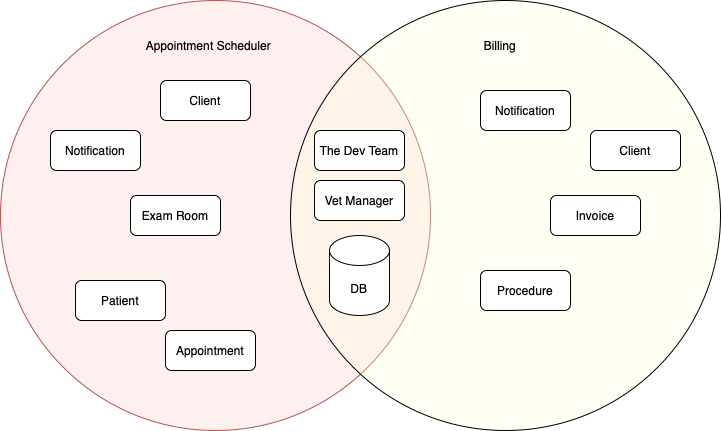Domain-Driven Design (DDD) is an approach to software development that focuses on modeling software based on the underlying business domain. This means that software is designed to closely reflect the business logic and processes, enabling better collaboration between developers and domain experts. DDD is especially useful for complex applications, where understanding the core business problem is essential to creating efficient and maintainable software.
1. What is Domain-Driven Design (DDD)?
Domain-Driven Design is a methodology introduced by Eric Evans in his book “Domain-Driven Design: Tackling Complexity in the Heart of Software.” The approach emphasizes collaboration between technical and business experts to ensure that the software meets business requirements while maintaining a clean, maintainable codebase. The focus is on defining a shared understanding of the problem domain and then implementing that understanding in the software.
In DDD, the “domain” refers to the core business logic that the software is designed to support. This could be anything from an e-commerce platform to a financial system. The goal is to align the code with the domain, so it evolves with business changes.
2. Key Concepts in Domain-Driven Design
1. Domain and Subdomains
- Domain: Refers to the main business area that the software aims to solve or manage.
- Subdomain: Larger domains are often divided into smaller, more manageable subdomains, each focusing on specific aspects of the business.
Why It Matters: A deep understanding of the domain and subdomains helps developers create solutions that match business needs.
2. Ubiquitous Language
- Ubiquitous language is a shared language used by both developers and domain experts. It ensures that everyone involved in the project is on the same page, using the same terms and understanding to avoid miscommunication.
Why It Matters: Ubiquitous language prevents misunderstandings and bridges the gap between technical and non-technical team members.
3. Bounded Context
- A bounded context is a specific part of the domain where a particular model is defined and used. Each bounded context has its own language, rules, and data, ensuring clarity and consistency within that context.
Why It Matters: Breaking down large domains into smaller bounded contexts helps maintain clarity and prevent confusion between different parts of the system.
4. Entities and Value Objects
- Entities: Objects that have a distinct identity that runs throughout their lifecycle, such as a customer or an order in a system.
- Value Objects: Objects that are defined only by their attributes and lack a distinct identity, like an address or a monetary amount.
Why It Matters: Understanding the difference between entities and value objects helps developers create a more organized and maintainable domain model.
3. Core DDD Patterns
1. Aggregates
An aggregate is a collection of related entities and value objects that are treated as a single unit for data changes. Each aggregate has a root entity that controls access to its internal members, enforcing invariants and business rules.
Why It Matters: Aggregates help manage complexity by ensuring that related data is consistent and encapsulated.
2. Repositories
Repositories provide an abstraction layer for accessing aggregates. Instead of working directly with databases, the domain logic interacts with repositories, which handle the storage and retrieval of data.
Why It Matters: Repositories ensure that domain logic stays separate from persistence logic, keeping the codebase clean and easier to maintain.
3. Domain Events
Domain events represent significant occurrences within the domain. These events are used to notify other parts of the system of changes, ensuring that actions within one bounded context can trigger responses in others.
Why It Matters: Domain events help build decoupled systems where components can react to changes without being tightly integrated.
4. Factories
Factories are used to create complex objects, such as aggregates, without exposing the logic behind their creation. This pattern helps simplify object creation while ensuring that the object is initialized with all the necessary data and relationships.
Why It Matters: Factories prevent the domain logic from being cluttered with object creation details, improving code readability and maintainability.
4. Strategic Design in DDD
Strategic design in DDD focuses on large-scale architectural decisions, including how to structure and organize different parts of the domain. This often involves defining boundaries between different subdomains and deciding how they interact.
1. Context Mapping
Context mapping visualizes the relationships between different bounded contexts and subdomains. These maps help identify how different parts of the domain interact, ensuring smooth communication and data flow across boundaries.
Why It Matters: Context maps provide a clear overview of system architecture and help identify dependencies and potential bottlenecks.
2. Anti-Corruption Layer (ACL)
An anti-corruption layer is used to isolate a bounded context from external systems or legacy code that may have different models or incompatible data formats. The ACL ensures that external influences don’t corrupt the internal domain model.
Why It Matters: ACLs protect the integrity of the domain model, allowing the internal system to evolve independently of external constraints.
3. Shared Kernel
A shared kernel represents a small, shared part of the domain model that multiple bounded contexts can use. It is important to manage and maintain shared kernels carefully to avoid dependencies that can stifle system evolution.
Why It Matters: Shared kernels allow parts of a system to reuse essential models and logic while keeping the majority of their codebase separate.
5. Advantages of Domain-Driven Design
1. Better Alignment with Business Goals
DDD encourages continuous collaboration between developers and business experts, ensuring that the software is always aligned with the core business logic and objectives.
2. Easier to Maintain and Scale
By breaking the system into smaller bounded contexts, DDD makes it easier to maintain and evolve the software over time. Each part of the system can be developed and scaled independently.
3. Improved Communication
With the use of ubiquitous language, DDD improves communication between developers and stakeholders. Everyone involved speaks the same language, reducing misunderstandings and miscommunication.
4. Increased Flexibility
DDD allows for changes in the business logic or structure to be easily reflected in the software. It makes the software more adaptable to future changes, which is crucial in fast-evolving industries.
Conclusion
Domain-Driven Design is a powerful methodology for developing complex applications that require close alignment between the technical implementation and the business logic. By focusing on the domain, using ubiquitous language, and organizing the code into bounded contexts, DDD helps build scalable, maintainable, and flexible software systems.
At TechsterTech.com, we specialize in building robust and scalable software solutions using industry-leading methodologies like Domain-Driven Design. Whether you’re starting a new project or refactoring a legacy system, our team is equipped to deliver high-quality software that meets your business needs.



